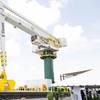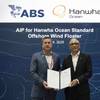Millennium Cell Inc., which designs and develops systems for the safe use of hydrogen fuel in energy applications, has teamed with Seaworthy Systems in a CCDOTT (Center for Commercial Development of Transportation Technologies) and California State University, Long Beach Foundation program. This program will demonstrate the benefits of using its fuel to power ships and facilities in ports. The project is designed to meet CCDOTT goals for zero emissions from fuel cells, and the contract award comes as many operators in U.S. ports are facing potential fines for being well in excess of Environmental Protection Agency air and water quality standards.
"So there's a movement afoot right now in California to add regulation to reduce emission for all of the maritime fleet," said Rex E. Luzader, vice president of Business Development for Transportation and Hydrogen-Fuel Infrastructure at Millennium Cell. "We're going to see more and more potential applications where hydrogen is either used in fuel cells to provide electricity with zero emissions or to burn in internal combustion engines for propulsion power with extremely low emissions."
Founded in 1998, Millennium Cell has invented and developed a proprietary process called Hydrogen on Demand that is designed to safely generate pure hydrogen or electricity from environmentally friendly raw materials. Sodium borohydride is made from borax, a material that is found in substantial natural reserves globally, with a particularly large supply in the U.S., prompting Millennium Cell to call their fuel, Freedom Fuel.
The Hydrogen on Demand system releases the hydrogen stored in the chemical bonds of sodium borohydride solutions by passing the liquid through a chamber containing a proprietary catalyst.
The reaction is totally inorganic, producing a high-quality energy without polluting emissions. Hydrogen is only produced — on demand - when the liquid fuel is in direct contact with the catalyst, thereby minimizing the amount of gaseous hydrogen present in the system at any given time. The fuel solution itself is nonflammable, non-explosive and safe to transport, minimizing many of the logistical issues associated with hydrogen.
Millennium Cell technology can be applied in transportation and portable power, including micro-power and longer-life batteries. This unique fuel system gives the Natrium a range potential of 300 miles, significantly longer than any fuel cell vehicle shown to date. In addition, the vehicle has zero emissions — no greenhouse gas or smog-forming compounds. The system can be used with fuel cells and diesel or gas turbine engines.
"Millennium Cell is providing visionary leadership in developing hydrogen fuel solutions for transportation, stationary and portable power and we are excited about the opportunity to assess the merits of the Hydrogen on Demand system in maritime applications — including hydrogen-powered fuel cells and internal combustion engines," said Matthew Winkler, vice president of Seaworthy Systems.
Luzader said the Hydrogen on Demand system has a variety of maritime uses. "It could be any application from propulsion to onboard electrical generation or anything in between," he said. "It could be backup power or distributed generation where you have multiple units on board serving various sections of the ship. Containerships could be towed into port by a clean-fuel vessel."
Another promising use of Hydrogen on Demand is in military applications, said Luzader. The use of an energy-dense fuel source that is nonflammable and non-explosive would be a tremendous asset to military on land and at sea.
"We've had discussions with the Naval Surface Warfare Center where, if they used fuel cells as the source of energy for propulsion, one possibility is that they could use our fuel as the source of hydrogen for the fuel cell," he said. "We could actually regenerate the fuel or the borate solution at sea and eliminate the supply chain. The ability to regenerate fuel at sea with the fleet is a unique proposition for the Navy that no other technology offers.
"They're operating on one possible premise that, beyond 2050, there may not be diesel fuel available for burning on board ship to generate power for propulsion," Luzader said. "So they're looking at other alternatives to produce propulsion power, and fuel cells would be one. Our technology would be an advantageous source of hydrogen for the fleet. The concept would be one in which you would have a ship within that fleet that would actually make sodium borohydride from the borates made aboard all the ships in that fleet powered by fuel cells using Hydrogen on Demand as the source of hydrogen. That's the program we've got on the table for consideration for the Navy of tomorrow."
Dr. Stephen S. Tang, president and CEO of Millennium Cell, said, "We expect the demonstration of the Hydrogen on Demand system in maritime applications will show how efficiently we can reduce air and water pollution in our seaports and waterways and provide a clean energy solution to help solve complex environmental issues."
Sponsored Content
Safer Starts Here: Build Ships, Protect Crews

Subscribe for
Maritime Reporter E-News
Maritime Reporter E-News is the maritime industry's largest circulation and most authoritative ENews Service, delivered to your Email five times per week











